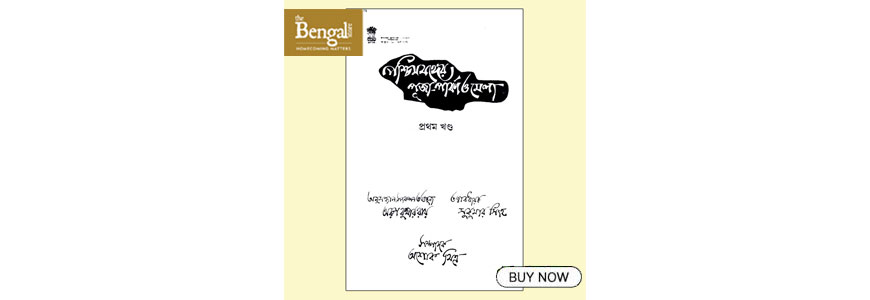Tracing the metamorphosis of Sri Aurobindo: A documentary from Bengal
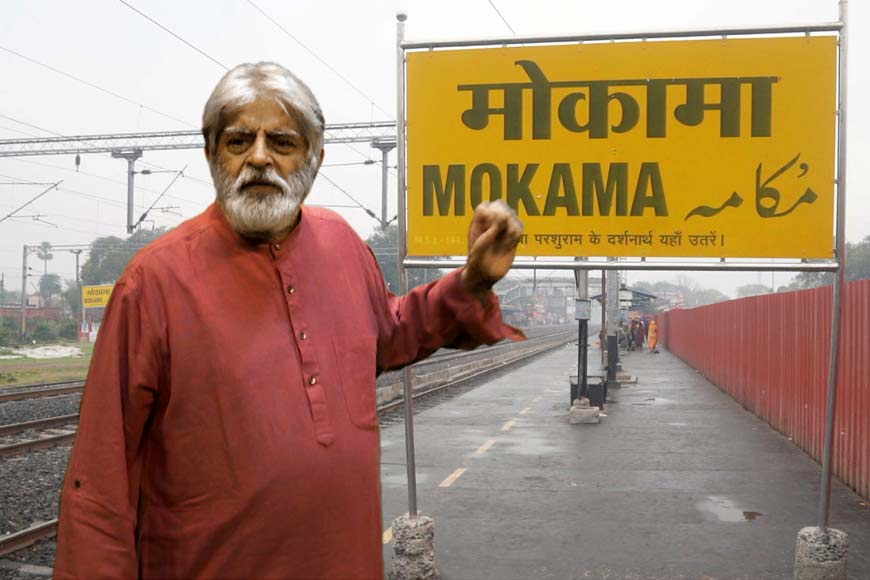
Jayant Kripalani - Mokama Rly Station
As India gears up for the 75th anniversary of its Independence this year, it is important to remember one more very significant occasion - the 15oth birth anniversary of Aurobindo Ghosh or Rishi/ Sri Aurobindo (born August 15, 1872), and one of the moving spirits behind the struggle for Independence.
Among his most important contributions was the initiation of his younger brother Barindra Ghose to the concept of open revolt against the British, inspiring him to recruit and train young men in guerrilla warfare. In 1907, Sri Aurobindo also launched ‘Yugantar’, a Bengali newspaper which propagated armed revolt against colonial rule.
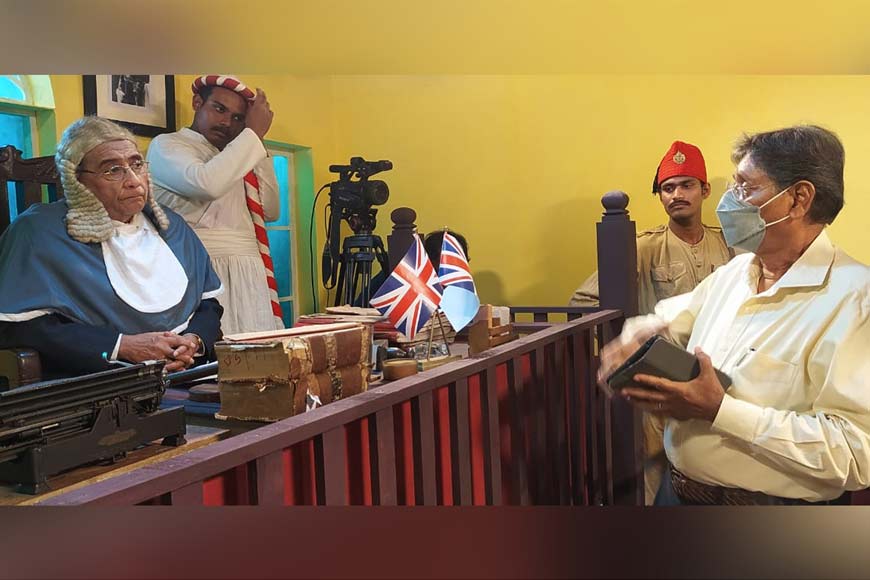 Briefing Judge Beachcroft - Pradip Miter
Briefing Judge Beachcroft - Pradip Miter
The brothers soon had a band of loyal followers who congregated at the Ghosh family’s Muraripukur garden house in north Kolkata, which became a hub for manufacturing and storing explosives and other arms and ammunition to fight the British, which eventually resulted in the notorious ‘Alipore Bomb Case’.
All of this finds place in a new docu-drama to mark Sri Aurobindo’s 150th anniversary, jointly produced by Sri Aurobindo Society Puducherry and Kolkata Sukriti Foundation. The 54-minute film, titled ‘The Transformation’ in English and ‘Naya Janma’ in Hindi, is directed by Abhijit Dasgupta, the former station director of Doordarshan Kendra Kolkata. The documentary was screened at Nandan III on August 11 and will be telecast for the first time on Doordarshan in both Hindi and English on August 14 and re-telecast on Independence Day itself.
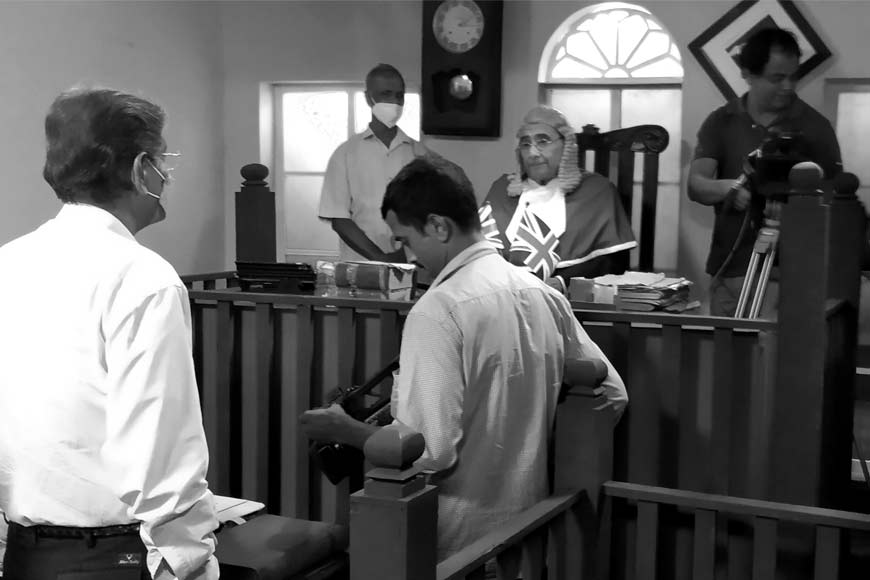 Briefing Pradip Miter as Judge Beachcroft
Briefing Pradip Miter as Judge Beachcroft
The film focuses primarily on the period between 1908 and 1909 when Sri Aurobindo was imprisoned in Alipore Jail in connection with the Alipore Bomb Case. Dasgupta uses raw footage and archival and stock footage interspersed with original documents such as the writings of Sri Aurobindo, narrative montages, voiceovers, interviews and re-enactments, artificially reconstructing settings such as the court of law where Aurobindo and ‘his allies’ were tried and the Alipore Jail campus, including the cell where Sri Aurobindo spent his days in solitary confinement.
The documentary also draws heavily on the wealth of information prepared by Dr Jayanti Mukherjee and her husband Dr Nirmalya Mukherjee, eminent scholars who have been extensively researching Sri Aurobindo for decades. For the last six years, Jayanti has been involved in a project initiated by Aurobindo Society to prepare a detailed study on ‘Sri Aurobindo in Contemporary Newspapers’.
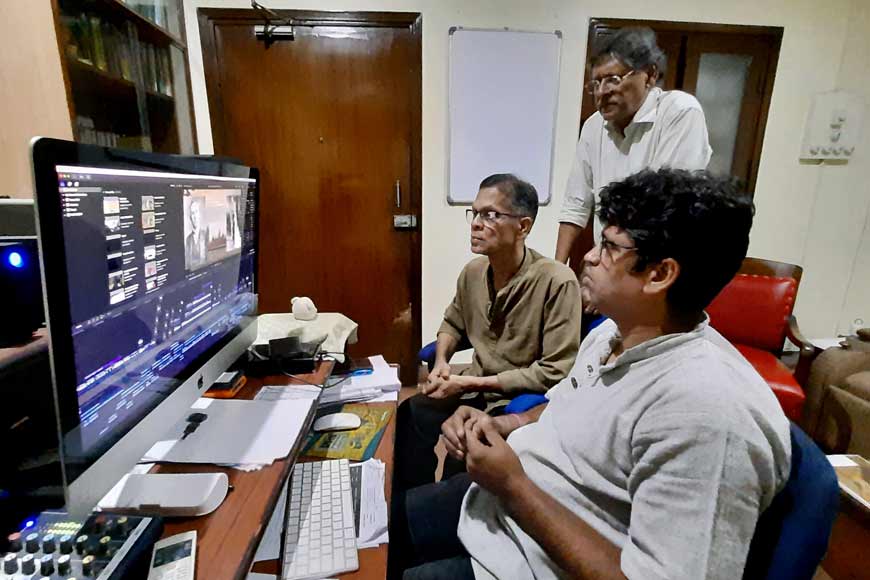 Editing in Progress
Editing in Progress
“I suggested I narrow down my area of research to a period between 1907 and 1910 because it is next to impossible to bring his entire career under one umbrella. So I started with Sri Aurobindo joining as the first principal of the newly-formed Bengal National College (predecessor of Jadavpur University) on August 14, 1906. I found mention of his activities in newspapers from 1907, starting with the Vande Mataram case, but Sri Aurobndo became the talk of the town following his arrest on May 2, 1908 in the Alipore Bomb Case,” says Jayanti.
Is that the reason why the documentary focuses on only one year of Sri Aurobindo’s life? Jayanti says, “There is so much information about the myriad aspects of his life as a nationalist leader turned ascetic and his works that it is next to impossible to cram it into a single documentary. That is why we focused on the Alipore Bomb Case, the first state trial of any magnitude in India.”
Also read : Did Aurobindo Ghosh wish for an Akhand Bharat?
In 1908, a plan was hatched to assassinate Douglas Kingsford, Chief Presidency Magistrate of Muzaffarpur. The task was entrusted to Khudiram Bose and Prafulla Chaki, who went to Muzaffarpur, targeted Kingsford’s carriage and hurled bombs at it as it emerged from the European Club on April 30, 1908. However, their attempt failed and two European ladies were killed in the attack instead. Cornered by the police at Mokama Railway Station a few days after the attempt, the 20-year-old Chaki shot himself and the 19-year-old Bose was arrested, to be hanged shortly afterward.
Again in early 1908, Barindra Ghosh and four of his associates gathered at Dhidhiria Mountains on the outskirts of Deoghar (Jharkhand) to test the potency of the bombs they had manufactured. Prafulla Chandra Chakraborty hurled the first bomb but failed to take cover and was blown to smithereens. Dasgupta and his crew followed the trail of all the revolutionaries to shoot at the actual locations, which have totally transformed with time.
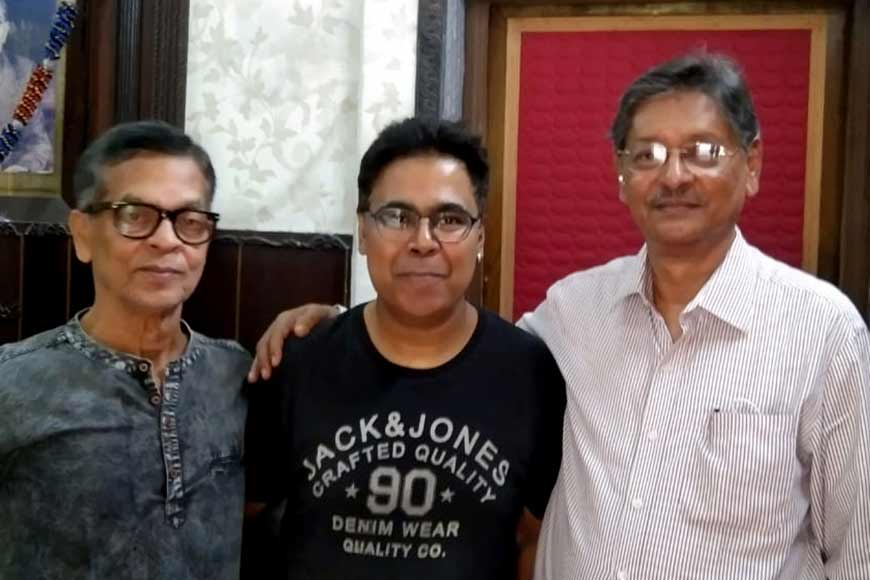 Editor Satyen Mohanty on left, Narrator Mir in the middle, Abhijit Dasgupta on right
Editor Satyen Mohanty on left, Narrator Mir in the middle, Abhijit Dasgupta on right
In the early hours of May 2, 1908, the police carried out simultaneous raids at several locations in Calcutta and arrested nearly 20 suspected revolutionaries including Sri Aurobindo, who was believed to be their actual leader and the chief conspirator. In ‘Tales of Prison Life’, Sri Aurobindo himself wrote this about the incident: “I was not aware at the time that the prime suspect was none other than me and the Police investigation featured me as the chief accused as well as the initiator and secret leader of the young Nationalist revolutionaries.”
The police recovered arms, ammunition, explosives and other documentary evidence. They also confiscated revolutionary literature and all the accused were taken into custody and charged with conspiracy and waging war against the King - the equivalent of high treason, punishable with death.
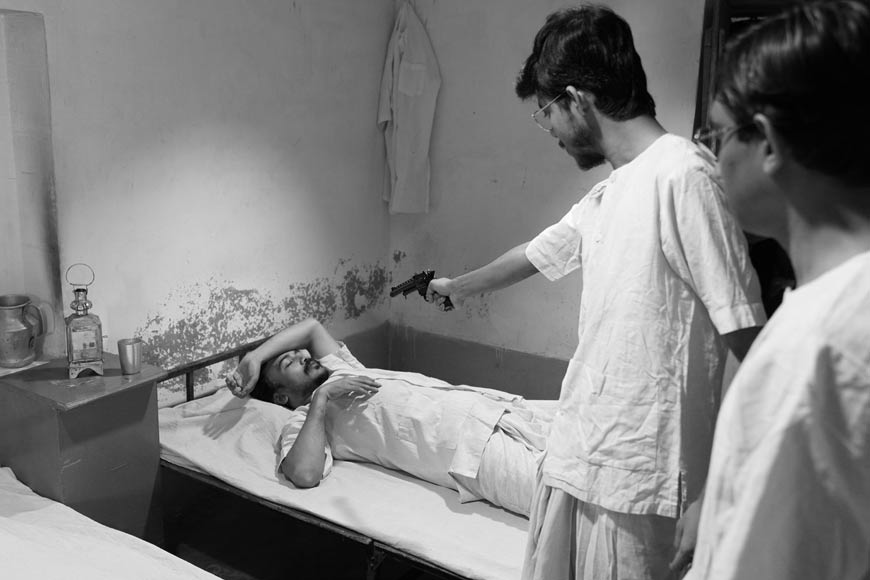 Kanai and Satyen fire at Naren Gossain
Kanai and Satyen fire at Naren Gossain
The case dragged on with preliminary hearings in the Magistrate’s court, involving 1,000 pieces of evidence and 222 witnesses, followed by a trial in the Sessions Court, involving 1,438 exhibits and 206 witnesses.
Dasgupta wanted to shoot inside Alipore Jail and the cell where Sri Aurobindo was detained during trial, but prison authorities did not comply, so sets had to be designed to recreate the cell. The courtroom drama, too, had to be shot on set. “Abhijit da lamented that a little cooperation from the authorities would have made the shooting so much more convenient and authentic. The costs also shot up owing to these extra expenditures. But I can vouch for how realistic everything looks,” says Jayanti.
Sri Aurobindo’s writings provide a detailed description of his cell: “My prison-cell was nine feet long and about five or six feet wide. This windowless cage, fronted by a large iron barred-door, was assigned to me as my abode. The cell opened into a very small courtyard, paved with stones and surrounded by a high brick wall. A wooden door led outside. The door had a small peep-hole at eye-level, for sentries to keep a periodic watch on the convicts when the door was closed. The door to the courtyard of my cell was generally kept open.” This vivid account undoubtedly helped Dasgupta’s trained mind to conceptualise the cell.
On May 6, 1909 after a year-long trial, Sri Aurobindo was acquitted of all charges with the judge condemning the flimsy nature of the evidence against him. Of the 37 men on trial, Barindra Ghose and Ullaskar Dutt, who manufactured the bombs, were given the death penalty (later commuted to deportation for life), 17 others were given varying terms of imprisonment or deportation and the rest acquitted. The director has depicted in detail the Cellular Jail in the Andamans and the condition of the prisoners deported to the prison to serve life terms.
The high-octane courtroom scenes were recreated by Dasgupta with the help of a host of well-known actors, such as Cyrus Madan as the prosecuting counsel Eardley Norton, Pradip Mitra as Judge Beachcroft and Ashoke Viswanathan as Deshbandhu Chittaranjan Das, who defended Sri Aurobindo.
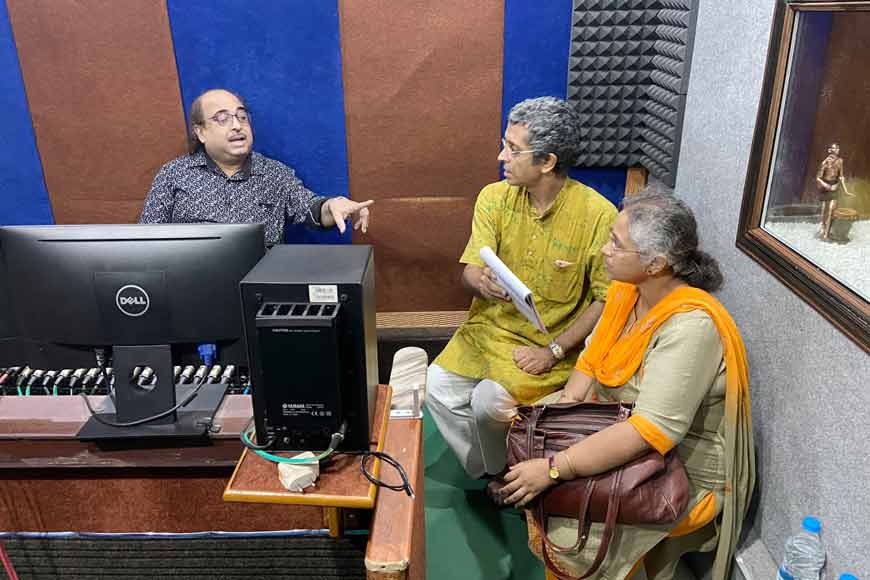 Music Session
Music Session
Both Jayanti and Nirmalya have been associated with the project since it was commissioned. “The Alipore Bomb case was an important court trial in India’s Independence movement. All contemporary newspapers, vernacular and English, reported the proceedings regularly. In fact, The Statesman, fully owned and operated by ‘pucca’ British journalists, reported impartially on the court proceedings. I spent hours in the National Library archives section, taking detailed notes from roughly 45 newspapers and journals of the time. Some of the reports have been used in the documentary,” says Jayanti.
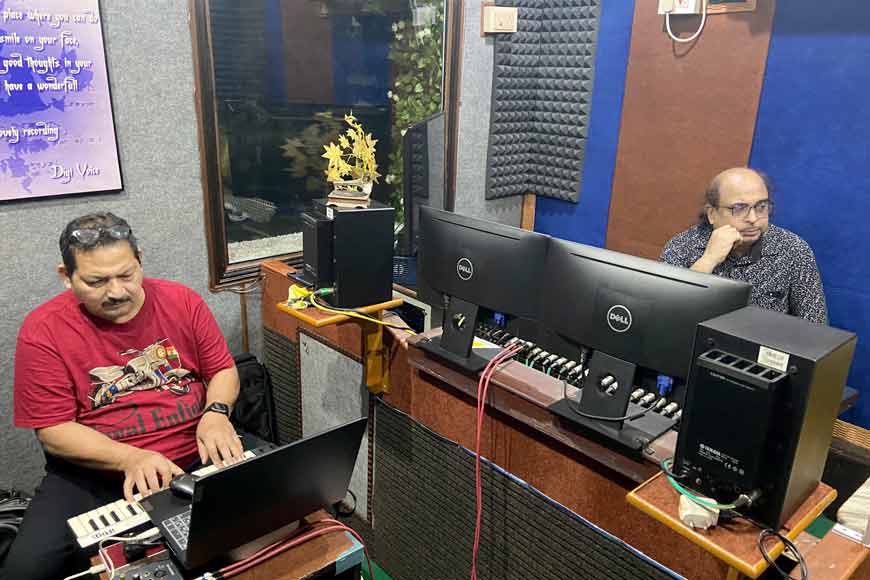 Music Session
Music Session
Sri Aurobindo gained spiritual realisation during his solitary imprisonment. After his release, he delivered a couple of speeches, the most famous being the one at Uttarpara Library, where he shared his mystic experiences. Dasgupta has briefly represented this aspect as well in his documentary, a timely tribute to one of the greatest sons of Bengal’s soil.








